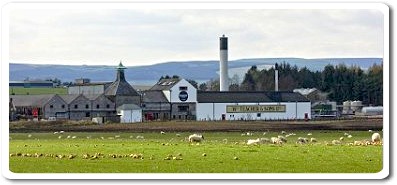
 Ardmore Distillery
Ardmore Distillery |
PRODUCTION – A GLIMPSE INTO THE CREATIVE PROCESS AT
ARDMORE MALTING Purchased to optimise fermentation and ultimately,
spirit yields, Ardmore uses locally grown barley for the purposes
of malting. Whilst this is no longer carried out on premises
(the Ardmore maltings closed in the 1960s), the distillery
staff still manage the process from grain purchase through
to malt production.
The characteristic peat flavour that differentiates ArdmoreTM
Traditional Cask from other mainland Malts is derived from
the peating levels specified during the malting process.
Classified as Light or Medium peated, Ardmore typically
peats its malts to between 12 to 14 parts per million. To
ensure local authenticity in the making of Ardmore, the
maltsters source the peat from a bog at New Pitsligo in
Aberdeenshire. Ardmore is the only Highland distillery to
have continuously used a
fully peated malt in the production of its spirit.
Stored in twelve 90 tonne bins, with a further four 50
tonne bins for overfill/emergency use, the distillery has
a total malt storage capacity of 1,280 tonnes; which is
pretty big by Malt distillery standards. This storage capability
allows the distillery to rest its malt for two to three
weeks before it is used.
MILLING The malted barley is crushed through
a traditional Boby Patent Two-High Mill, believed to date
from the 1930s. This creates the Grist a mixture of husk
material, coarse grits and fine flour. Sugars will be extracted
from the grist during the mashing process.
MASHING The Ardmore Mashtun reflects the
idiosyncratic nature of the Ardmore distillery, comprising
as it does a cast iron body (good for heat retention), with
stainless steel semi-lauter mashing gear. The distillery
will mash 12.48 tonnes of malt to generate 60,000 litres
of Wort, the sweet liquid from which the spirit will be
fermented.
Unlike other malt distilleries Ardmore mashes its second
water at an exceptionally high temperature of 95oC. (Most
distilleries will do this at between 85 to 90oC.) The third
water is applied at a temperature close to 100oC to ensure
the maximum extraction of sugars from the Grist. The Sparge
is then collected and used as the first water for the next
Mash.
Ardmore draws its water from 15 springs on the Knockandy
Hill some 1,425 feet above sea level and due North of the
distillery; cooling water comes from the burns nearby.
FERMENTATION Ardmore has ten 45,000 litre
and four 90,000 litre Washbacks (fermentation vessels) which
are made from Scottish Douglas Fir. The distillery has resisted
the temptation to install stainless steel vessels, believing
that additional flavour compounds are derived through fermentation
in wood.
60,000 litres of Wort is placed into each individual (or
pair of) washbacks, to which a blend of Distiller's
Yeast is added. The fermentation head is left to develop
for a period of between 53 and 60 hours.
DISTILLATION Ardmore's four Wash
Stills and four Spirit Stills make it one of the biggest
malt distilleries in
Scotland, capable of producing approximately five million
litres of spirit per annum.
The Wash Stills are charged at 15,000 litres and Low Wines
collected for between five to five and a half hours. The
Spirit Stills, which are differentiated by their slightly
longer necks, are charged at a slightly higher level of
15,500 litres with the distillation cycle lasting for about
eleven hours.
All Spent Lees (spirit distillation waste) is treated through
the distillery's own copper removal plant, which is
believed to have been the first in the Scotch whisky industry.
Since the conversion from direct fired coal to indirect
steam heating in 2001, Ardmore now make two types of spirit,
Ardmore (fully peated) and Ardlair (unpeated). Ardlair is
named after a set of standing stones a few miles from the
distillery and it is principally used for blending by other
distillers as a blending malt.
MATURATION Young, high in strength and
colourless, the spirit must grow old in wood, mellowing
and maturing while it takes on the colour, taste and aroma
of casks of seasoned oak. At Ardmore the majority of the
spirit is used to produce
Teacher's® Highland Cream. Spirit destined for
Teacher's is placed in large Spanish oak Puncheons
holding up to 550 litres. Here it will sit for around six
years slowly maturing before blending.
The maturation of ArdmoreTM Traditional Cask takes place
in ex-American Bourbon Barrels holding 190 litres of spirit.
Matured on site the casks will lie awaiting the time when
the Master Blender believes they are ready, before being
transferred to quarter casks for finishing.
Reflecting more traditional times before standard bottling
age became the norm, no hard or fast rules apply to the
time the spirit will lie in either cask or indeed when it
will be bottled. This is down to the judgement and experience
of the Master Blender who will decide when the spirit is
right.
Distillery tours are by appointment only, please call: +44
(0)1464 831 213
KEY FACTS AT A GLANCE
1898 Established by William Teacher & Sons.
1958 Another pair of stills added.
1975 An additional four stills added creating
an eight Still configuration and one of the largest Malt
distilleries in Scotland.
1976 Taken over by Allied Brewers, subsequently
to become Allied Distillers.
1999 Rare Single Malt distillery release
a 12 Year Old to mark the centenary of Ardmore.
2001 Direct coal-firing of stills ends
following Still House fire – required by 2006 to comply
with EU regulations.
2002 As part of Her Golden Jubilee tour,
the Queen and Prince Phillip stayed in the Royal Train which
was parked up at the Ardmore sidings overnight. Somewhat
characteristically, the Distillery Manager commented that
whilst sister distillery Laphroaig has the HRH feathers
Ardmore hosted the Queen!
2005 Acquired by US based company Beam
Global Spirits & Wine, Inc.
2007 Ardmore produces and releases its
first widely available commercial
Malt, ArdmoreTM Traditional Cask in Duty Free and the UK.
2008 Ardmore Traditional Cask launches
in the U.S.
Courtesy
of Ardmore Distillery |

